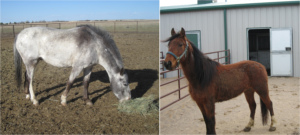Different Strokes for Different Folks

Horses are kept and cared for in a variety of different ways. One may not be better than the other. Horses are highly adaptable and can learn to be content in all kinds of environments.
As an American farrier that has shod horses from coast to coast and border to border for over five decades, I am amazed at the many different ways people care for their horses. What is considered neglect in some areas, in another is considered responsible care. There is variance in area and in breeds, types and uses of horses.
These different attitudes are reflected in horse keeping practices, service expectations, and prices for farrier work. In some of the more metropolitan areas horses are kept in beautiful barns with roomy stalls, protected from insects by sprays and blanketed in cold weather. Horses competing at high levels are pampered and indulged. They are fed only the best ‘natural’ foods fit for a king’s table. Farrier’s arrive in fancy rigs and horses are always shod consistently at a specified interval. Superior skill and business practices make a high price seem less disagreeable.
These differences are not only based on economic level of the owners. Shoeing gaited horses is much more complex than shoeing race horses. Yet, race horses can be much more expensive to own and care for. The quality of the work may not be directly related to the price expected. It is not uncommon to see the more expensive horses shod by the least proficient craftsmen. Part of this is no doubt due to cultural expectations, but a lot of it appears to be due to ignorance of true principles by owners and trainers.
Horses that are depended upon for regular hard use are kept in various ways. Some are kept in stalls with regular turnout, but more are kept in pastures and fed hay and only enough grain to catch and reward them for a day’s work. A dry lot where they are fed twice daily is most common. Horses don’t seem to mind the less pampered treatment.
Big ranch remudas are often kept in small pastures and are only grained when they are worked. The horses seem to take it well and are perhaps happier than those kept in close confinement. Horses are very adaptable. Farrier work may be done by the owner. Sometimes it may be poorly done. When it is done by a professional farrier, the price will not be what it could be in a more metropolitan area. Shoeing intervals may be longer than ideal.
Cultural differences must be taken into account. Not everyone appreciates the same things. Quality of life, including life style and closeness to family are important considerations. The key is to be happy where you are and in doing what you are doing. Some of the best farriers I have met are not necessarily the best paid. They love their work and it shows. They are constantly improving by competing with themselves. Their customers recommend them by saying, “He or she is my farrier.” That is the highest form of compliment.
Where you live and the type of horses you chose to work on are not as important as how you feel about your work. Having an attitude of gratitude is most important. How you feel about your work is detectable by even the most distracted horse owner. The privilege of earning a living with horses, fire and hand tools is a wonderful thing.
This time of year, is a good time to evaluate your business and personal goals. Are you grateful?
Related Posts
-
The question of whether or not a horse owner should shoe his...Aug 30, 2018 / 0 comments
-
This month, the House Judiciary Committee will vote on the 2...Jan 05, 2018 / 0 comments
-
In the fall, as the temperatures drop, horses will get some ...Nov 17, 2016 / 0 comments
Blog Categories
- Anatomy
- Best Business Practices
- Conformation
- Current Events
- Customer Service
- Draft Horse Shoeing
- Equine Soundness
- Essential Anatomy Kit
- Farrier Careers
- Farrier training
- Foal soundness
- Horse Care
- Horse Foot Care
- Horse Owner Tips
- Horsemanship
- Horseshoeing
- Horseshoeing History
- Iron and Forge Work
- Student Spotlight
- Uncategorized
- Veterinary Care
Blog Archives
Contact Us
Butler Professional Horseshoeing School
495 Table Road
Crawford, NE 69339
(800) 728-3826
jacob@dougbutler.com
Subscribe to Our Blog
Get Our Free e-Book!
If you think you want to become a farrier (or know someone who does), this book can help you make that decision. Horse owners will learn the importance of choosing a qualified farrier and how to select the “right” one.
[ Get the e-Book Now! ]
- Follow:
